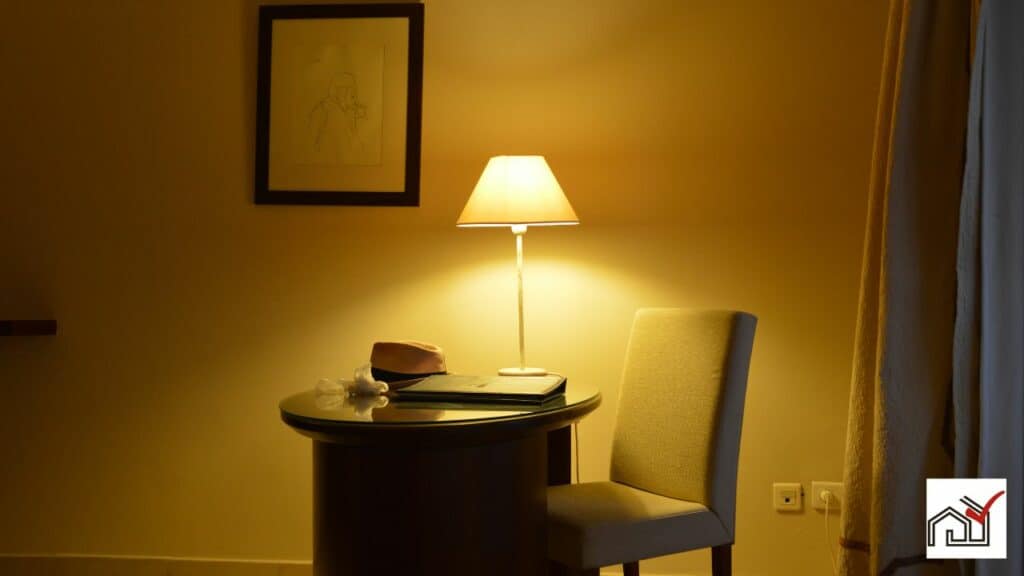Choosing the right size lampshade is important for both lighting and aesthetics. The width of the lampshade should generally be twice the width of the lamp base, and the height should be about one-third of the total lamp height for a balanced look.
The lampshade should also cover the lamp's harp and bulb socket. Proper lampshade sizing involves considering proportion, the size of the room, and functionality.
Assessing Room Dimensions
When choosing a lampshade, select a size that fits the room and furniture proportions. The ideal lampshade acts as both a light source and a design element. For floor lamps, ensure the shade size matches the lamp's height and space it occupies. Disproportionate shades can unbalance the lamp's appearance.
To measure a lamp, first look at the base width. This measurement is crucial for both floor and table lamps. The shade width should generally be twice the base width for visual balance. The shade height should be one-third of the total lamp height, including the base and the attachment mechanism.
When considering room layout, match the style and size of lampshades to the surrounding furniture and space. Although visual references can help, the aforementioned sizing principle is a solid guideline for maintaining proportionality.
For replacing a lampshade, measure the top and bottom diameters, the slant from top to bottom, and the vertical height of the existing shade. These dimensions will help you find a new shade that fits well with the room's decor and atmosphere.
Lamp Base Proportions
When choosing a lampshade, it's important to match it to the lamp base's size to ensure visual balance and proper lighting. The lampshade's bottom diameter should generally be twice as wide as the lamp base's widest part to avoid a top-heavy or too narrow appearance. The shade's height should also be considered and is ideally one-third of the lamp's total height, which helps the lampshade and base appear as a unified entity.
For tall, thin bases, a taller shade is suitable, while shorter shades work better with short, wide bases. The golden rule equation can help achieve aesthetically pleasing proportions. Additionally, the lampshade's shape should correspond to the base shape; round shades for round bases, and square or rectangular shades for angular bases. Using visual examples can aid in understanding how to choose the right lampshade for balance.
Choosing Shade Shapes
Choosing the right shape for a lampshade is important. It must match the lamp base's design and meet lighting requirements. A harmonious combination of base and shade is key for a good look. Shades with angles work best with geometric bases, such as cylinders or cubes. Square or rectangular shades pair well with angular bases and provide a modern look.
Consider the lamp's location when choosing a shade shape. Square or rectangular shades fit well against walls or in small spaces. Measure the bottom of the lampshade to make sure it fits the intended area.
For lamp bases with a specific style, like Asian designs, choose a shade that matches the theme. A Pagoda style shade can enhance an Asian-inspired base. A shade that doesn't match the base can disrupt the room's look.
As a rule, the bottom diameter of the shade should be close to the height of the lamp base for balance. This ensures the lamp looks proportionate and appealing. A well-chosen lampshade contributes to the lamp's functionality and the room's aesthetics.
Measuring for Lampshade Fit
To find the right size lampshade, follow these steps:
- Measure the height and width of your lamp base. The height should be measured from the bottom to just below the bulb socket. This measurement will guide the shade's height, which is ideally about two-thirds of the base's height.
- Measure the width of the lamp base at its widest part. This measurement will help determine the lampshade's bottom diameter. The shade should be wider than this part of the base to avoid looking top-heavy.
Consider these additional tips:
- If you prefer visual guidance, consider watching a video demonstration that shows how to measure and choose the right lampshade size.
- Another option is to use the golden rule equation to calculate the optimal lampshade dimensions. This equation takes into account the base's height and width to determine the ideal proportions for the shade.
Balancing Style and Function
Choosing the right lampshade requires balancing its look with its usefulness. The lampshade size should match the lamp height for a balanced appearance. A mismatched size can affect the lamp's appearance and lighting. To find a suitable shade width, double the width of the lamp base. This helps achieve visual balance and proper light spread. The lampshade shape should complement the lamp base for a unified look.
Consider the lamp's purpose, whether for general, focused, or decorative lighting. This determines the shade material and how it allows light to pass through. A well-chosen lampshade complements the lamp and room while serving its lighting purpose, making it an important part of the room's design.





